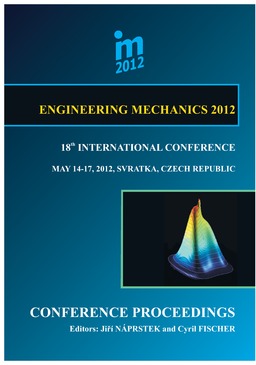Proceedings Vol. 18 (2012)

ENGINEERING MECHANICS 2012
May 14 – 17, 2012, Svratka, Czech Republic
Copyright © 2012 Institute of Theoretical and Applied Mechanics, Academy of Sciences of the Czech Republic, v.v.i., Prague
ISBN 978-80-86246-40-6 (electronic)
ISSN 1805-8248 (printed)
ISSN 1805-8256 (electronic)
list of papers scientific commitee
pages 1229 - 1235, full text
The paper deals with hydraulic design of an inducer. The mathematical model based on the Lagrange coordinates is presented. It is based on a choice of trajectory of a fluid particle in accordance with the continuity equation. Given the trajectory shape, it is possible to determine the specific energy of an inducer. The inducer blade is then determined by the family of these trajectories. Key words: Inducer, Euler equations, Continuity equation, Lagrange coordinates 1 Introduction When designing an inducer, the main criteria are high suction performance, high head rise and a positive pressure gradient. Currently, the design methods to avoid cavitation in inducers are becoming a major concern. This article provides relatively quick and easy methodology to do the preliminary blade design satisfying demanded parameters, while focus is put on suitable specific energy and pressure gradient. Cavitation in inducers is studied in the papers (Rebattet et al 2001; Acosta et al 2001; Wegner et al 2003). No attempts to improve the cavitation performance have been made here. Let us consider the helical surface in the coordinate system ! ! !!! ! !! ! !! !. This surface rotates around axis !! with angular velocity !. We connect the rotating coordinate system ! ! !!! ! !! ! !! ! with the helix. In the system !! we may write down the general parametric helical surface as 2 Liquid Motion on a Helical Surface !! ! ! !! ! !! !"# ! !! ! !! ! !! !!! !! ! ! !! ! !! !"# ! !! ! !! ! !! !!! !! ! ! !! !!! (1) where !! ! !!! ! !!! , !! ! !! !!! and !! is fixed in the interval !! !! . In !! this surface is given by !! ! ! !"#! ! ! !" !!! !! ! ! !"# ! ! !" !!! !! ! !! !!! (2) Helix’s shape is defined. To describe the motion of a fluid particle on this helix we choose the Lagrange coordinates, while this particle will be moving in the opposite direction of axis !! . In general, this motion is described by !! ! ! !! ! !! ! ! !"# ! !! ! !! ! !! ! ! !!! !! ! ! !! ! !! ! ! !"# ! !! ! !! ! !! ! ! !!! !! ! ! !! ! ! !! and in system !! must satisfy the Continuity Equation (Brdi!ka et al 2005), which in Lagrange coordinates takes the form ! ! ! !!!!. Substituting from (2) and solving the determinant, we get * Ing. Ji"í Stejskal: Energy Institute, Brno University of Technology, Faculty of Mechanical Engineering, Technická 2896/2; 616 69, Brno; CZ, e-mail: jstejskal@gmail.com Stejskal J. 2.1 ! ! !! !" !" !" ! ! ! !!! !!! !!! !!! 301 (3) Important Relations for the Inducer Design With the defined motion in hand, we are ready to express some important quantities in terms of functions !, ! and !. The circumferential velocity component !! is given by and for the blade angle !, we have 2.2 Pressure !! ! ! ! ! ! !! !" ! ! ! ! ! ! !! !! !!! "#$! (5) The pressure field can be determined from the Euler equations, which in Lagrange coordinates take the form (Brdi!ka et al 2005) ! ! ! !! !!! ! ! !! !!! ! ! !! !!! !" !! !! !! !! !!! ! !!!!!!!! ! !! ! !! ! !! !! !! !! !"! ! ! ! !" !" !" !! !! !!! !!! !!! !!! !!! !" !!! ! ! ! ! ! ! ! !!! !!! (6) Using equations (2) in (6), we obtain equations describing the pressure field as ! ! ! (7) Now we are ready to design functions !, ! and ! such that the inducer satisfies demanded parameters. The inducer blade surface is then given by equations (1). 3 Conclusions This paper presents the methodology to design an inducer blade. It is based on Euler equations together with the continuity equation in Lagrange coordinates. It can be used to perform the preliminary blade design and to predict its parameters (specific energy, pressure gradient, etc.). Several inducers were designed and compared to numerical computations. It was shown that these numerical results are in good agreement with the presented theory. Acknowledgement The financial support of the Specified Research Grants No. FSI-J-12-21/1698, No. FSI-S-12-2 and NETME Centre project - New technologies for Mechanical Engineering CZ.1.05/2.1.00/01.0002 is gratefully acknowledged. References Rebattet, C., Wegner, M., Morel, P. & Bonhomme, Ch. (2001) Inducer design that avoids rotating cavitation. CREMHyG’s research report. Acosta, A. J., Tsujimoto, Y., Yoshida, Y., Azuma, S. & Cooper, P. (2001) Effects of Leading Edge Sweep on the Cavitating Characteristics of Inducer Pumps. International Journal of Rotating Machinery, 7(6), pp.397-404. Wegner, M., Acosta, A. J. & Tsujimoto, Y. (2003) Panel Discussions on Inducer Design Criteria. International Journal of Rotating Machinery, 9, pp.229-237. Pochyl#, F., Stejskal, J., Haluza, M. & Rudolf, P. (2011) Hydraulick! návrh induceru. Brno University of Technology research report No. VUT-EU 13303-QR-20-11. Brdi!ka, M., Samek, L. & Sopko, B. (2005) Mechanika kontinua. Academia, Praha.
back to list of papers
Text and facts may be copied and used freely, but credit should be given to these Proceedings.
All papers were reviewed by members of the scientific committee.

 Powered by
Imce 3.20 © 2023, Pavel Formánek, Institute of Thermomechanics AS CR, v.v.i. [generated: 0.0288s]
Powered by
Imce 3.20 © 2023, Pavel Formánek, Institute of Thermomechanics AS CR, v.v.i. [generated: 0.0288s]